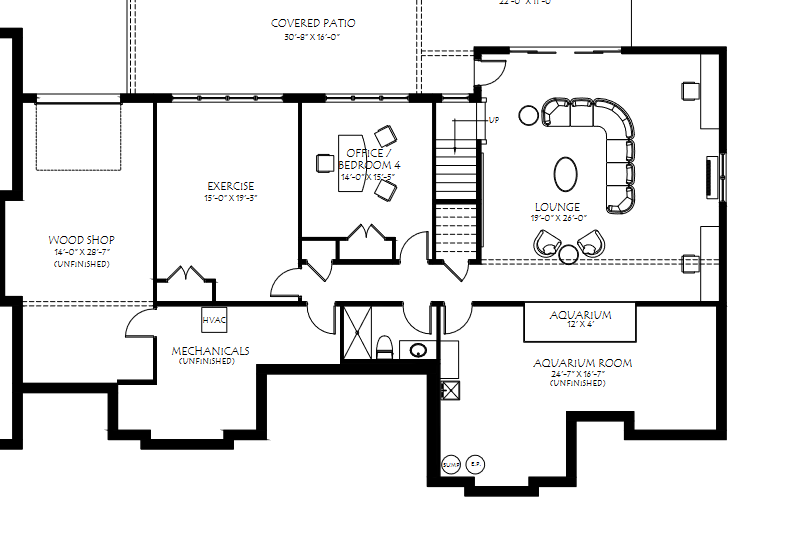- Joined
- Mar 23, 2018
- Messages
- 159
- Reaction score
- 84
How is everyone controlling the heat and humidity of their aquarium rooms?
We're in our process of building a home and we're planning on putting in a 1000+ gallon aquarium in our basement. The aquarium itself will sit into a wall and behind it will be an unfinished maintenance room for the aquarium.
The question we have from our builders is what's the best way to manage heat and humidity in this room. Google isn't much help because this is pretty far outside the beaten path for standard questions. We live in kentucky and humidity during the summers is commonly over 80%.
This is the plan for the basement:

We'd like to avoid a chiller for the aquarium and instead use evaporation to cool the aquarium. We've currently got a 320 gallon and that's what we do for it. Fully automated ATO with an RO refilling it.
We had three thoughts on how to manage the humidity and heat, but we are far from the experts and would love input from you guys.
First idea: Vent in aquarium room
If we put an exhaust fan in the aquarium room, we can run the fan whenever the temperature or humidity reaches problematic levels in the room. This should create negative pressure and pull conditioned air from the rest of the house to both cool and dehumidify the room. As long as the house's humidity and temp is below a problematic level (it will be), this should work.
Second idea: Vent in aquarium room, ERV in house
Building on the previous idea, vent in the aquarium room to remove hot, humid air and pull cooler, drier air from the house. To save on HVAC costs, an ERV could be used inside the home to keep us from losing all the conditioning that went into the air that's getting sucked into (not out of) the aquarium room.
Third idea: ERV or HRV in aquarium room
If we put an ERV or an HRV in the aquarium room, we could ventilate the room with fresh air from the outside without sucking conditioned air from the house into the aquarium. However, my knowledge of ERV's and HRV's are extremely limited. Would one of these allow us year round humidity control? We wouldn't want to pull outside air into the room during the summer without dehumidifying and cooling it, or at the very least, dehumidifying it. One benefit of this route is easy pH control through fresh air for the skimmer.
Would love thoughts, suggestions and ideas
We're in our process of building a home and we're planning on putting in a 1000+ gallon aquarium in our basement. The aquarium itself will sit into a wall and behind it will be an unfinished maintenance room for the aquarium.
The question we have from our builders is what's the best way to manage heat and humidity in this room. Google isn't much help because this is pretty far outside the beaten path for standard questions. We live in kentucky and humidity during the summers is commonly over 80%.
This is the plan for the basement:

We'd like to avoid a chiller for the aquarium and instead use evaporation to cool the aquarium. We've currently got a 320 gallon and that's what we do for it. Fully automated ATO with an RO refilling it.
We had three thoughts on how to manage the humidity and heat, but we are far from the experts and would love input from you guys.
First idea: Vent in aquarium room
If we put an exhaust fan in the aquarium room, we can run the fan whenever the temperature or humidity reaches problematic levels in the room. This should create negative pressure and pull conditioned air from the rest of the house to both cool and dehumidify the room. As long as the house's humidity and temp is below a problematic level (it will be), this should work.
Second idea: Vent in aquarium room, ERV in house
Building on the previous idea, vent in the aquarium room to remove hot, humid air and pull cooler, drier air from the house. To save on HVAC costs, an ERV could be used inside the home to keep us from losing all the conditioning that went into the air that's getting sucked into (not out of) the aquarium room.
Third idea: ERV or HRV in aquarium room
If we put an ERV or an HRV in the aquarium room, we could ventilate the room with fresh air from the outside without sucking conditioned air from the house into the aquarium. However, my knowledge of ERV's and HRV's are extremely limited. Would one of these allow us year round humidity control? We wouldn't want to pull outside air into the room during the summer without dehumidifying and cooling it, or at the very least, dehumidifying it. One benefit of this route is easy pH control through fresh air for the skimmer.
Would love thoughts, suggestions and ideas













